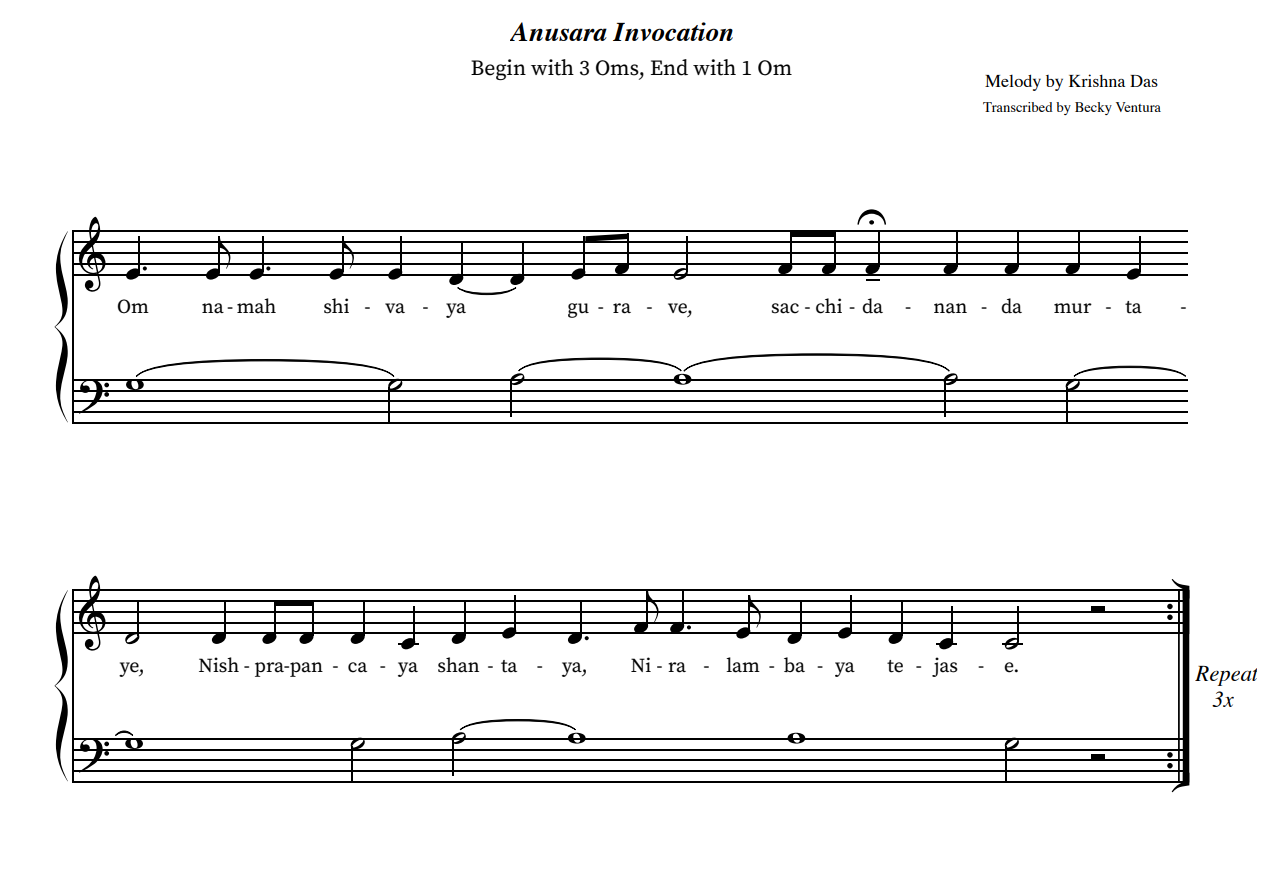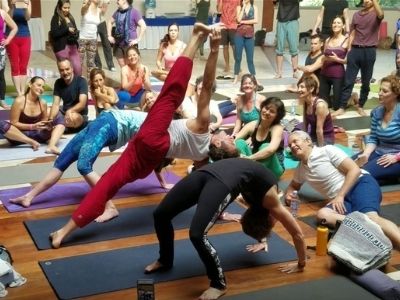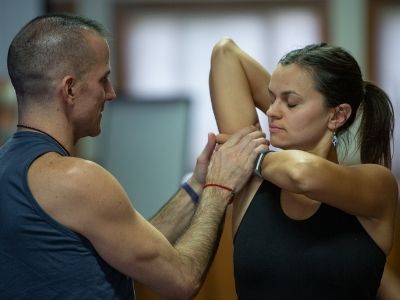
Anusara is yoga with heart.
Explore Anusara’s Invocation. Learn more about the words and translations, watch videos of the sung invocation, and see sheet music if you are interested in playing the Anusara invocation on a musical instrument.
Discover more about Anusara’s invocation by reading our Frequently Asked Questions (FAQ’s).
Anusara Invocation
Anusara’s invocation is in an ancient language called Sanskrit.
Om Namah Shivaya Gurave
Saccidananda Murtaye
Nisprapancaya Shantaya
Niralambaya Tejase
Om

Translations of the Anusara Invocation
This English translation reflects a general sentiment of the actual Sanskrit words. The translation may work for singing.
I open my heart to the power of Grace
That lives in us as goodness
That never is absent and radiates peace
And lights the way to transformation
This literal translation comes directly from the Anusara Teacher Training Manual used globally in our teacher training programs. This translation provides a bit more depth to each section of the Sanskrit stanzas.
Om
Namah Shivaya Gurave
I offer myself to the Light, the Auspicious One,
who is the True Teacher within and without,
Saccidananda Murtaye
Who assumes the forms of Reality,
Consciousness, and Bliss,
Nisprapancaya Shantaya
Who is never absent and is full of peace,
Niralambaya Tejase
Ultimately free and sparkles with a Divine luster .
Om
Here is another translation of the Anusara Invocation. This translation also comes from the Anusara Teacher Training manual. This translation deeply connects to Anusara yoga’s philosophy.
I bow to the presence of the Divine within
Our true and highest teacher
That lives in and around us as
Being, consciousness and bliss.
It is ever-present and radiates peace
Lighting the way to transformation.
Om
Word by Word Translation of Anusara Invocation
Enjoy a fuller review of the Sanskrit words used in the Anusara invocation and understand what each word means. The Anusara Invocation also connects to the Methodology of our global yoga school.
OM
A sacred syllable symbolizing the Absolute, the Universal Energy that lives in all of us. Om represents the “soundless sound,” the eternal vibration of life essence.
As science has discovered, there is a constant subtle hum to the universe. Yogis know that we are all connected by these harmonics of being.
Om is the vibration that the universe is making at its most subtle and sublime level. Through this awareness, the yogin (practitioner of yoga)
sees the Self in all things.
Namah Shivaya
Namah means to honor or to bow with respect. Shiva translates literally as “auspicious,” “good,” or “benevolent.”
Namah Shivaya is know as a maha mantra, or great mantra ,and has been chanted for hundreds of years. The chant says, “I recognize that the ground of being is goodness, and I honor this goodness in myself and in all beings.”
Gurave
Gu means “darkness,” and ru means “remover,” or “destroyer.”
Gurave means to bow to the teacher, especially the teacher within.
In the outer world, the guru is the energy that you can listen to as a teacher. The guru can be your partner, your children, your dog, or even a place in nature that speaks to you.
Sat-chit-ananda
Literally, these three words from Sanskrit mean
• Being (sat)
• Consciousness (chit)
• Bliss (ananda).
This phrase – satchitananda – refers to the experience of unconditional or non-referential awareness experiencing itself in form as bliss, joy or ease of being.
The phrase describes a moment of awareness resting in its true nature, like a drop of ocean water being absorbed into the peace of the ocean.
Murtaye
Murtaye literally means “image,” or “form.” The word refers to images that invoke the qualities of expansion, peace, and balance.
Murtaye can apply to literal images of Krishna, Jesus, Buddha, etc. or to inner visualizations such as the many visualization practices in Tibetan Buddhism. The word also refers to the inner image one creates of oneself.
Nisprapancaya
A power of Grace that is never absent. This word refers to a current or river of life energy, prana, or life force, that always runs through our lives.
By aligning more and more with this current, we may create transformation and balance in the current of energy through our own bodies and spirits.
Shantaya
The Sanskrit word Shanti means “peace” and refers to a balance of mind. When the mind is poised delicately and intentionally between the past and the future, awareness can rest in its true nature, which is an expansive state of non-referential peacefulness.
Niralambaya Tejase
A quality of light or illumination that exists eternally and is independent in its existence.
Spiritual traditions worldwide reference light as a symbol of the expanded Self and/or Divine.
Luminosity is an attribute of the life force (prana) and is an agent of transformation.

Free Resources
Enjoy learning about the Anusara Invocation from our extensive collection of free resources from our global yoga teaching community.
Learn how to prepare to chant the Anusara Invocation
Dive deeper. Integrate the Anusara Invocation into your asana practice. If you are interested in leading the Anusara Invocation, discover some cues and tips. Enjoy an asana practice that Invokes the Invocation as a teaching theme.
Free Lectures about the Anusara Invocation
Enjoy these in-depth presentations from our Anusara Scholars and Subject Matter Specialists.
Videos of Chanting Anusara Invocation
Enjoy this collection of videos of people chanting the Anusara Invocation from Anusara’s YouTube channel. Subscribe to our YouTube channel to enjoy additional free yoga continuing education and resources. As you play these videos, sing along to the Anusara invocation.
Sheet Music for Anusara Invocation
Play the Anusara Invocation on a musical instrument. You may use this sheet music for a harmonium, guitar, piano, and sitar. Explore using any string instrument or wind instrument to play the Anusara Invocation.
Download a PDF of the sheet music.

Discover Potential
Discover your unlimited potential through key elements that are the hallmark of Anusara.
Find Your Path
Get started today.
Find a class, workshop, teacher near you.
Find local, regional, and global events.
Frequently Asked Questions (FAQ’s)
Krishna Das created the melody for the Anusara Invocation.
The Anusara Invocation is from the Niralambaya Upanishad. This chant is also used by other traditions including Siddha Yoga.
The Anusara Invocation is a way to remember why we have gathered together in community.
When we sing together, we harmonize and unite our voices. We listen to the voices around us. By paying attention, we attune to one another.
The invocation sets our intention. It is a way of recognizing our highest intention for our yoga practice.
The word Invoke means
• to call on
• to summon
• to cause something to be carried out.
Anusara yoga declares that the way to know and live these teachings is to embody them.
When we take our seat and chant the invocation, it is a whole-hearted, purposeful act of earnest, focused, enthusiasm for our practice.
From the dawn of creation’s emptiness, primordial sound arises. This is a reoccurring element in many origination myths from cultures all around the world.
Throughout time, manifest existence, the something coming from nothing, begins with a sound.
Om encapsulates the essence and process of Asana practice and Yoga practice. It is a remembering or a recognition.
Om or AUM
A – The creative impulse
U – The task of Maintenance
M – Permission for dissolution
Silence









